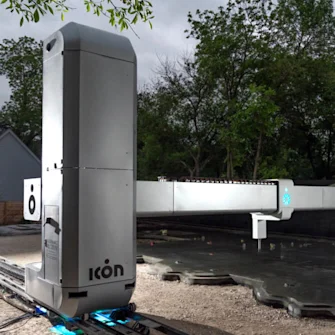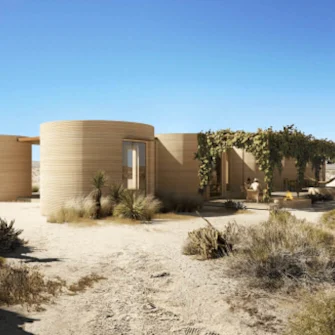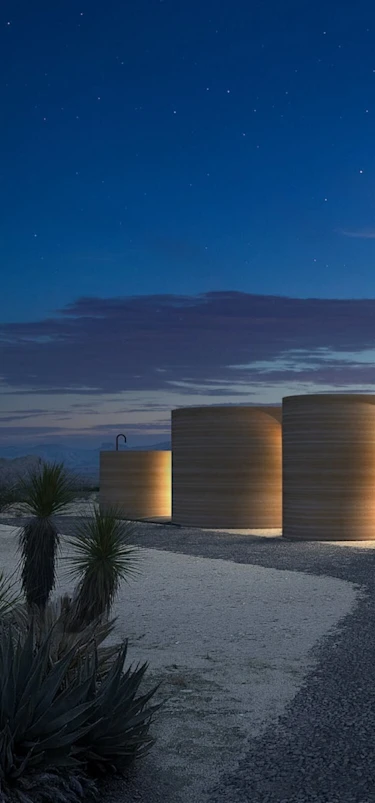3D
Design
March 23, 2023
Bjarke Ingels Pushes Toward a 3D-Printed Future
New projects unveiled last week at South by Southwest by the Danish architect give us a glimpse at the future of housing.
Words by Ian Volner
Photos courtesy ICON
In an interview session at Austin’s SXSW omni-conference last week, Bjarke Ingels staged a minor media coup. Sitting opposite host Wajahat Ali, live on camera before a virtual audience of tech enthusiasts, culture vultures and assorted combinations of the two, the Danish-born architect and international design gadabout announced “an open call to all architects on earth,” inviting them to compete for a cash prize of $1 million, to be awarded to the best proposal for a 3D-printed house costing less than $99,000. “It’s a way to take affordable housing and make something extraordinary out of it,” he said.
Extraordinary is right. For several years now, a global battalion of technological wiz kids and design-world compatriots have been trying to find ways to make computer-drafted, robotically assembled buildings a practical reality. “It’s really a response to the high costs and relatively low productivity of conventional construction labor,” notes Greg Lindsay, an urban-futures specialist and former senior fellow at the NewCities Foundation. Instead of a crew of on-site workers laying bricks and mortar and welding steel joints, the 3D-printing concept would see digital designs translated directly into full-size structures via huge mechanical arms, capable of stacking precast members or pouring layer upon layer of hard-drying goo into the desired shape.
Already the technique has yielded some fairly eye-catching results — a remarkable stainless steel bridge in Amsterdam by designer Joris Laarman, completed in 2021; a miniature concrete viaduct in Venice, created in 2021 by Zaha Hadid Architects’ experimental design wing — but thus far, most of the realized projects have been small-scale proofs of concept. For Ingels and his collaborators, the new competition is an attempt to push 3D printing into the mainstream.

And that’s not all they’re doing. Alongside the starchitect, the main backer of the global contest, titled Initiative 99, is Austin’s own ICON, a 3D-printing construction company that’s quickly become one of the most active and ambitious commercial players in this still-emerging corner of the industry. Using a proprietary substance called Lavacrete, poured in place by a gigantic gantry-like printing machine, ICON has been making strides on a range of potential 3D applications, running the gamut from the practical to the (very) far-out. On the one hand, the outfit has helped build a series of houses outside the Texas capital, combining both printed and off-the-shelf materials and techniques; at the same time, the team was commissioned by NASA to explore the possibility of machine-built structures on the surface of the moon. As speculative as that program may sound, ICON CEO Jason Ballard has minced no words regarding the company’s ultimate goal of creating “humanity’s first construction on another world,” and NASA has come through with a nearly $60 million contract to pursue the idea.
In the meantime, ICON and Bjarke Ingels Group (BIG) will be joining forces on a project somewhat closer to home, meant to demonstrate the kind of technical and aesthetic legerdemain they’ll be expecting from the Initiative 99 entrants. In the rural arts colony of Marfa, Texas, the designers and builders will be unveiling a unique luxury resort, set to begin construction next year on the dusty highland plains of the Trans-Pecos.

Their client is Texas hospitality magnate Liz Lambert: Alongside her other celebrated properties, including the Hotel San José and Hotel Saint Cecilia in Austin, the hotelier has been operating a high-end campground in Marfa since 2011. While keeping its (appropriately spacey) name, El Cosmico, the hotel will now undergo a radical transformation, moving to a nearby 62-acre site where its trailers and tents will be upstaged by a series of stunning hut-like structures, designed by BIG and built using ICON’s innovative tech.
“The organic forms, curves and shapes we’re able to make with the 3D printer are magical,” says Melodie Yashar, ICON’s Vice President of Building Design and Performance, who sees the Marfa design as showing what’s possible with the new technology — as well as setting a lofty standard for the Initiative 99 competitors. Rising in sand-colored, stratigraphic layers of printed composite, with beds and other furniture built directly into the structure, each of El Cosmico’s desert dwellings suggests the retreat of some sage, futuristic hermit, a place to commune with the spirits before taking a dip in the huge circular pool at the center of the complex.
Speaking from the South By stage, Ingels looked beyond the glamorous appeal of the resort, to what he believed is the immense power of the technology behind it. “All the things we make many of” — cars and cellphones, for example — “become better and better, and at a more attainable cost,” he said. “That’s because of scale. That’s what technology can give you.” The fact that housing, seemingly the most essential of human products, has thus far been immune to that process is among the more confounding features of the modern economy, one whose devastating social impact is only too well known.
So can 3D printing finally crack the code? Only a few months before the Initiative 99 announcement, BIG and ICON broke ground on a 100-house development in Georgetown, Texas. Comprising single-family dwellings of the old-fashioned, gable-roofed type, the project certainly looks marketable, but with starting prices around the $450,000 mark, it hardly appears to be a silver bullet for America’s affordability crisis. As Greg Lindsay puts it, the near-term architectural impact of computer-guided construction is likely to remain somewhat abstract, producing “shapes and aesthetics” that can “build more excitement than a 3D-printed subdivision.”
Bureaucratic red tape; unresolved technical issues; the whole over-financialized structure of the American housing market, perhaps the worst culprit in the inflation of home prices over the past three decades — all of these stand in the way of a fully automated construction industry, and will doubtless take years (or more) to untangle. Projects like El Cosmico give us a glimpse at the future, which remains distant. But there’s $1 million waiting for anyone who can get us a little closer.

